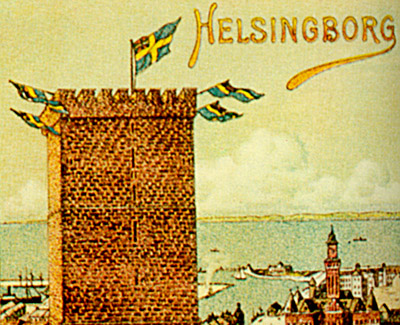| Fremtidsoptimisme

| | Fremtidsoptimismen omkring århundredeskiftet gav sig bl.a. udtryk i en omfattende udstillingsvirksomhed på tværs af landegrænserne, hvor man fremviste sine produkter og formåen.
Den første nordiske Kunst- og industriudstilling fandt sted i København i 1871 og i 1903 er Helsingborg værtsby. 1914 åbnede den første baltiske udstilling i Malmø, men midt under udstillingen brød 1.verdenskrig ud. |
Fremtidsoptimismen omkring århundredeskiftet gav sig bl.a. udtryk i en omfattende udstillingsvirksomhed på tværs af landegrænserne, hvor man fremviste sine produkter og formåen.
Den første nordiske Kunst- og industriudstilling fandt sted i København i 1871 og i 1903 er Helsingborg værtsby. 1914 åbnede den første baltiske udstilling i Malmø, men midt under udstillingen brød 1.verdenskrig ud.
Udstillingernes tidsalder
1800-tallets fremskridtsoptimisme kom klart til udtryk i de mange verdensudstillinger som blev arrangeret og som skulle vise alt det, mennesket nu var i stand til at frembringe. Disse store spektakulære begivenheder gik hånd i hånd med den hurtige industrielle ekspansion i Europa.
Efter den første verdensudstilling i London i 1851, fulgte Wien i 1873 og Paris i 1889. Fremvisningen af varer, bygninger, kunstværk og opfindelser var en slags vejviser for fremtiden, og nogle gange blev usædvanlige bygningsværker efterladt som minder om udstillingerne, som f.eks. Eiffeltårnet i Paris.
Også Norden blev grebet af udstillingsiveren og i Øresundsregionen kunne man bl.a. opleve såkaldte Kunst- og Industriudstillinger i København i 1872 og 1888. I Helsingborg åbnede Oskar II i juni 1903 en Industri- og Kunstudstilling og indviede samtidigt terrassetrapperne under Kärnan. Lund indbød til en udstilling i 1907, hvor størstedelen af byparken blev anlagt.

Industriudstilling i Helsingborg 1903 |
Øresund og Østersø
Den store baltiske udstilling i Malmö i 1914 fik den største opmærksomhed. Man gik ud fra at folkene rundt Østersøen hørte sammen, og denne tanke blev et vigtigt tema for den Baltiske Udstilling. Udstillere fra Danmark, Tyskland, Rusland og Sverige skulle demonstrere hvad industri og kultur i disse lande kunne tilbyde. Udstillingen skulle anskueliggøre alt, hvad landene omkring Østersøen havde til fælles. Det sydvestlige Skåne regnede med at få stor betydning som nyt centrum i den Østersøregion, som forventedes etableret efter den hurtige udvikling at færgefarten mellem Malmö og København og togfærgeforbindelsen fra Trelleborg til Tyskland.
Trafikknudepunkt Øresund
Skåne var således, trafikpolitisk set, havnet mellem Danmark og Østeuropa. Det sydlige Øresund var blevet et virkeligt centrum for passagertrafik og det drejede sig ikke bare om lokale transporter. København udvikledes til en betydningsfuld havn for skibsfarten til USA. En del emigranter rejste, men også slægtninge til emigranter, som tog af sted for at aflægge besøg. Mange tidligere emigranter vendte også hjem til Skandinavien og København og Malmö blev vigtige anløbssteder for de tilbagevendende.
Den baltiske Udstilling 1914
Interessen for udstillingen var stor i hele regionen. Ferdinand Boberg, jugendstilens store arkitekt i Sverige, var manden bag den stilmæssige udformning af udstillingsbygningerne. Den industrielle afdeling domineredes af svenske virksomheder, men danske og tyske industrier var også godt repræsenteret.
Det viste sig dog svært at tiltrække en større mængde russiske udstillere. Så var man mere heldig med at udstille en righoldig russisk kunstsamling. Mange af de russiske kunstgenstande blev tilbage efter udstillingen. I den turbulens som verdenskrigen og den russiske revolution havde skabt, blev de aldrig sendt tilbage, og Malmø Museum har derfor en interessant afdeling med russisk kunst.

Baltisk udstilling i Malmø 1914 | 
Mikhail Terestjenko | 
Rutschebane |
Krigen kommer
Midt under udstillingen udbrød den første verdenskrig, hvilket betød at russere og tyskere blev fjender. Udstillede tyske biler blev kaldt hjem, mennesker blev nervøse og besøgstallet faldt. Det blev en brat opvågnen fra drømmerne om en Østersøregion. Den svenske journalist og forfatter, Jan Olof Olsson, beskrev afslutningen af udstillingen:
”Under den Baltiske udstilling udbrød verdenskrigen – den skånske festsommer forbyttedes i katastrofe. Der lå megen symbolik i at udstillingens kendetegn, verdens højeste trætårn, faldt sammen under et stormvejr."

Tyskere læser krigsnyheder |
|